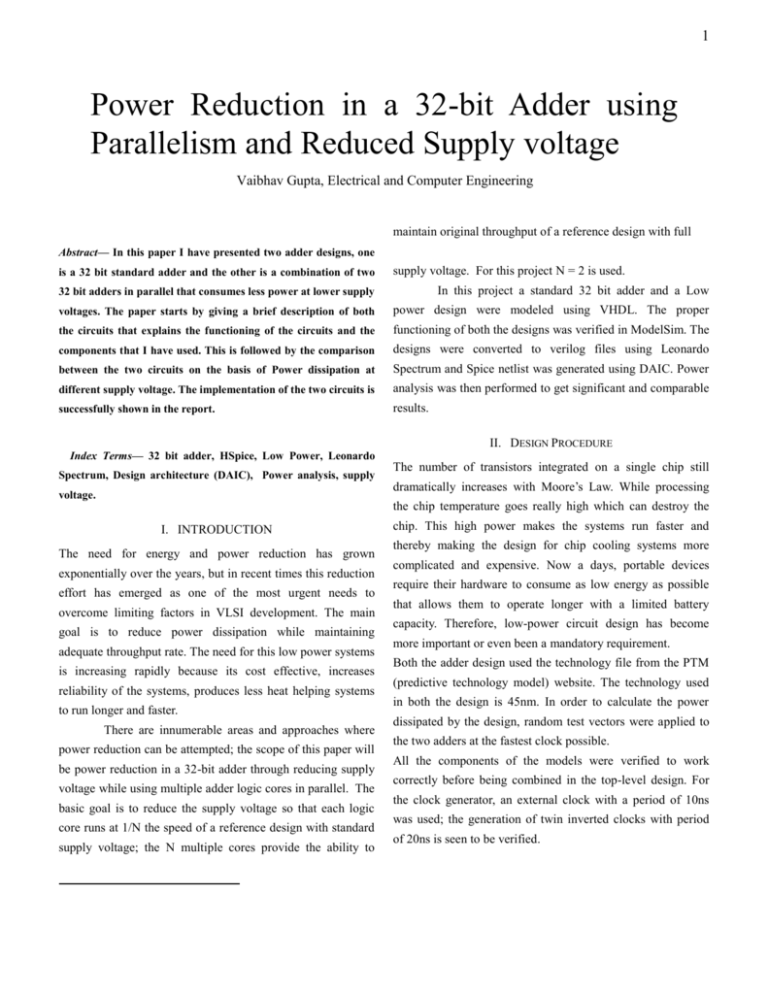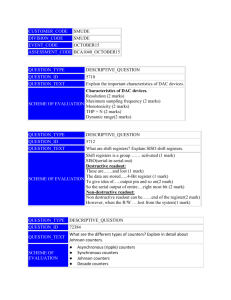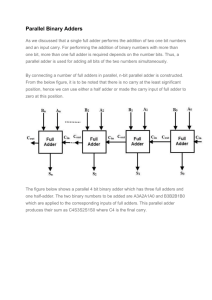spectrum parallel
advertisement

1 Power Reduction in a 32-bit Adder using Parallelism and Reduced Supply voltage Vaibhav Gupta, Electrical and Computer Engineering maintain original throughput of a reference design with full Abstract— In this paper I have presented two adder designs, one is a 32 bit standard adder and the other is a combination of two supply voltage. For this project N = 2 is used. 32 bit adders in parallel that consumes less power at lower supply In this project a standard 32 bit adder and a Low voltages. The paper starts by giving a brief description of both power design were modeled using VHDL. The proper the circuits that explains the functioning of the circuits and the functioning of both the designs was verified in ModelSim. The components that I have used. This is followed by the comparison designs were converted to verilog files using Leonardo between the two circuits on the basis of Power dissipation at Spectrum and Spice netlist was generated using DAIC. Power different supply voltage. The implementation of the two circuits is analysis was then performed to get significant and comparable successfully shown in the report. results. II. DESIGN PROCEDURE Index Terms— 32 bit adder, HSpice, Low Power, Leonardo Spectrum, Design architecture (DAIC), Power analysis, supply voltage. The number of transistors integrated on a single chip still dramatically increases with Moore’s Law. While processing the chip temperature goes really high which can destroy the I. INTRODUCTION The need for energy and power reduction has grown exponentially over the years, but in recent times this reduction effort has emerged as one of the most urgent needs to overcome limiting factors in VLSI development. The main goal is to reduce power dissipation while maintaining adequate throughput rate. The need for this low power systems is increasing rapidly because its cost effective, increases reliability of the systems, produces less heat helping systems to run longer and faster. There are innumerable areas and approaches where power reduction can be attempted; the scope of this paper will be power reduction in a 32-bit adder through reducing supply voltage while using multiple adder logic cores in parallel. The basic goal is to reduce the supply voltage so that each logic core runs at 1/N the speed of a reference design with standard supply voltage; the N multiple cores provide the ability to chip. This high power makes the systems run faster and thereby making the design for chip cooling systems more complicated and expensive. Now a days, portable devices require their hardware to consume as low energy as possible that allows them to operate longer with a limited battery capacity. Therefore, low-power circuit design has become more important or even been a mandatory requirement. Both the adder design used the technology file from the PTM (predictive technology model) website. The technology used in both the design is 45nm. In order to calculate the power dissipated by the design, random test vectors were applied to the two adders at the fastest clock possible. All the components of the models were verified to work correctly before being combined in the top-level design. For the clock generator, an external clock with a period of 10ns was used; the generation of twin inverted clocks with period of 20ns is seen to be verified. 2 lower the processing speed III. DESCRIPTION OF 32-BIT ADDER 2. The model was implemented on lower supply voltages which reduces gate delay and decreases frequency 3. The 'CL' block reduces the frequency to F/2 and feed that to the two adders in parallel. By reducing the frequency the critical delay of the circuit increases and the computation takes longer to complete and the circuit consumes more energy. V. POWER ANALYSIS Figure 1: Standard 32-bit adder In order to do the comparison and get data, the above two Fig. 1 shows the standard 32-bit adder. It has 64 bit input circuits were first simulated in Modelsim. Then the Leonardo vector (2x32 bit), 33 bit output vector (32bit + 1) and there is spectrum was used to get the synthesized verilog net list which one cycle delay for result. The frequency of the 32 bit adder is was imported in Design architecture to get the SPICE net list. F and the time period is 1/F. The SPICE net list was modified for 45nm technology and the The 32 bit adder is implemented using combinational logic which is called into a top level model. The top level model clocks the whole circuit with the rising edge. The codes for the 32-bit ripple carry adder were compiled in Modelsim to verify the outputs. The outputs obtained from the simulation of the circuit were as expected. HSPICE simulation was run for random vectors. The final output was checked using EZ waveform. For the purpose of ease in calculation, each model would use an external clock of 100MHz for a 10ns period. Leonardo had calculated the critical delay for each model; I used this value and the 45 nm standard 1.5V used for frequency calculation with the formula F = k x (Vdd - IV. DESCRIPTION OF THE LOW POWER 32-BIT ADDER Vt)/Vdd, where k is a frequency proportionality constant, and Vt is 0.34V for 45nm. This produced a k = 138.4MHz, which was then used to calculate frequencies at the following voltages: Figure 2: Low Power 32-bit Adder Vdd (V) Frequency (MHz) 1.4 141 1.2 99 0.9 86 0.7 71 Table 1: Vdd vs. Frequency Figure 2 shows the Low power design of the 32-bit adder. It has the same inputs and outputs as the standard design. The The 1.4V and 1.2V were chosen for the top model; 'CL' block takes in a frequency F and produces a divided down 1.4V would provide a good amount of slack at 100MHz but clock with frequency of F/2. Each adder uses a divided down frequency of F/2. 1. The low power model uses two 32-bit adders in parallel to provide a decent baseline to measure the reduced power. 1.2V would provide a supply voltage closer to 100MHz, which saves the power on slack and gives us a lower power. This 3 value would be lower as compared to the power value at 1.4V. A list of randomly generated vectors were created in a vector The power reduction of 1.2V would not be as much as in other file. Those vectors were forced into each bit line of the input cases with lower supply voltages. vector The power reduction in case of 0.9V and 0.7V was for simulation of power. The average power was measured using HSpice and verified using EZwave. The table much higher as compared to 1.2V. In both the cases the above frequency lowers leading to the increase in the critical path adder and the low power 32-bit adder. From Figure 3 It can be shows the comparison between the standard 32-bit delay. Other supply voltage values were also tested but the seen clearly that as the voltage goes down the power power generated from those values were orders of magnitude dissipated decreases. The power reduction in case of low lower. Actually on lowering the supply voltage the frequency power 32-bit adder is much lower than standard 32 bit adder. of the circuit decreases and it takes much longer for the output There is close to 75% reduction in the power with respect to to be produced at the clock transition, and thus dynamic power 1.4V supply voltage . Good power reduction is still seen with is not dissipated. Therefore those voltage values were ignored respect to 1.2V supply voltage. power analysis. Much of this power savings is due to the higher power Standard 32 bit adder Low_Power 32-bit adder Vdd 1.4V 1.2V 0.9V 0.7V Frequency(MHz) 100 100 100 100 produced by the standard model by producing the work much faster than it needs to. In the Low power design the frequency fed to the two parallel adders is F/2 therefore it takes longer for processing and we see low power dissipation. Once unnecessary speed above 100MHz is marginalized with the 0.9V supply, power savings of ~75% are seen; furthermore Power % Reduction(1.4V) % Reduction(1.2V) 649.38 407.62 167.44 154.81 - - 74.21% 76.16% - - 59.01% 69.02% savings of nearly 60-65% are seen with 0.7V. It must be noted that even in the standard design as the supply voltage is Table 2: Table showing comparison of Power reduced from 1.4V to 1.2V the power reduced by almost 37%. The reason for this is because lower supply voltage leads to lower frequency and thereby lower critical delay which in turn leads to lower power dissipation. VI. CONCLUSION In this project a standard 32-bit adder and reduced power 32bit adder were successfully implemented. It was successfully shown through experimentation that implementing a parallel scheme for the functional components of a design and reducing the supply voltage to each parallel component can significantly reduce the power dissipation. The results are discussed in the above section. The functioning of the two circuits and there components were simulated in Modelsim simulator. Simulation results confirmed the proper functioning of the two adder circuits. Best results for comparison are against the 1.4V supply, where ~75% reduction was seen. This is a significant improvement over simply reducing the voltage and proves this scheme to be effective for power reduction. Figure 3: Change in power with voltage 4 VII. FUTURE WORK A lot of work can still be done on this topic, such as instead of using 2 32-bit adders in parallel we can use 3,4,5 or more adders in parallel and we can measure power for this range parallel adder implementation. Another thing that can be done is to use a lower technology file like 32nm which would have more number of transistors. Moreover more efficient coding can also lead to a better design and computation VIII. REFRENCES [1] Mathew, Sanu, Mark Anders, and Ram Krishnamurthy. "Low power adder." U.S. Patent Application 10/425,987. [2] Shams, Ahmed M., Tarek K. Darwish, and Magdy A. Bayoumi. "Performance analysis of low-power 1-bit CMOS full adder cells." Very Large Scale Integration (VLSI) Systems, IEEE Transactions on 10.1 (2002): 2029. [3] Shalem, R., E. John, and L. K. John. "A novel low power energy recovery full adder cell." VLSI, 1999. Proceedings. Ninth Great Lakes Symposium on. IEEE, 1999. [4] Chandrakasan, Anantha P., Samuel Sheng, and Robert W. Brodersen. "Low-power CMOS digital design." IEICE Transactions on Electronics 75.4 (1992): 371-382. [5] Bui, Hung Tien, Yuke Wang, and Yingtao Jiang. "Design and analysis of low-power 10-transistor full adders using novel XOR-XNOR gates." Circuits and Systems II: Analog and Digital Signal Processing, IEEE Transactions on 49.1 (2002): 25-30. [6] Radhakrishnan, D. "Low-voltage low-power CMOS full adder." Circuits, Devices and Systems, IEE Proceedings-. Vol. 148. No. 1. IET, 2001. [7] He, Yajuan, Chip-Hong Chang, and Jiangmin Gu. "An area efficient 64-bit square root carry-select adder for low power applications." Circuits and Systems, 2005. ISCAS 2005. IEEE International Symposium on. IEEE, 2005.








